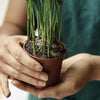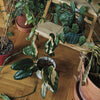How come I keep spilling my maids? Revealing the secret of dressing!

This article will certainly be useful for all growers who take care of plants with all their love, but still overwater them. Don't worry, you're not alone. Spilling is one of the most common mistakes that our customers confide in us. Many beginners have coded in themselves that the plant should not receive an excessive amount of water and this leads to overwatering. This belief often results in plants not getting as much water as they actually need, especially for tropical plants that prefer wetter environments. But what if we told you that the problem with overwatering is not the amount of water you give your plants, but the frequency of watering? And what if wet soil isn't as harmful as many of us think?
Understanding how to properly water plants is critical to their overall health and survival. It's not as simple as watering them when you think they're thirsty or when the soil looks dry. The art of watering takes into account a number of factors such as the type of plant, its native environment, current environment, season and even the type of pot it is in.
In this article, we'll help you understand how to recognize overwatering , how to avoid it, and most importantly , how to find the right balance of watering for your tropical plants to ensure they not only survive, but thrive.
When we talk about waterlogging, many people imagine a plant drowning in water. However, it is not that simple. Waterlogging is not so much a matter of the volume of water you give the plants, but rather of the frequency of watering . Plants do not like their roots to be in water for long periods of time as this can lead to root rot and other diseases. Waterlogging occurs when plants are watered too often , not when they receive a large amount of water at once. It may seem counter-intuitive, but plants need to pour the substrate well around the perimeter of the pot with each watering and then let it dry to a certain depth (which varies with different plant species).
Understanding Tropical Plants
To understand the concept of overwatering and why frequency of watering matters more than quantity, take a moment to look at where tropical plants actually come from and what they are adapted to. In their natural environment, tropical plants are used to a cycle of heavy rains followed by periods of drying. The soil they grow in is usually quick-drying, which means that even if they get a lot of water, the excess won't be retained and cause problems.

These plants are adapted to store water in their leaves, stems or roots , allowing them to survive until the next downpour. Therefore, tropical plants can handle (and even prefer) a good watering - if, of course, we give them time to use the accumulated water before the next watering.
In our homes, we mimic this natural cycle by watering plants thoroughly and waiting for the top layer of soil to dry before watering them again . (The easiest way to find this out is to stick your finger in the substrate and if it's dry, water the plant ) This procedure ensures that we don't just pour water onto the soil, but that we allow the plant to absorb, store and then use up the water it needs before it gets more.
So what are the symptoms of overwatering a plant?
Yellowing leaves:
Although yellow leaves can be a symptom of several problems, one of the most common causes is overwatering. If you notice that the leaves of your plant are turning yellow, especially if they are accompanied by brown spots , this may be a sign that you are watering too often. When the roots are constantly wet, they lack oxygen, which leads to plant stress, often manifested by yellow leaves.

Wasting :
You might think that wilting plants need more water, but that's not always the case. Overwatering can also cause plants to wilt . When the plant has too much water , the roots can become waterlogged and lack oxygen, leading to wilting and wilting of the leaves . It's a bit ironic that both overwatering and lack of water can cause wilting, so it's very important to check the soil moisture before reaching for the watering can.

Root rot :
This is one of the most serious symptoms of waterlogging . Root rot occurs when plant roots remain in water for too long, leading to the growth of fungi and bacteria that can cause root decay. This rot can be fatal to the plant because it limits the plant's ability to take up water and nutrients . You may not notice root rot until it is in an advanced stage, but if you notice an unpleasant smell or a mushy feeling when touching the soil, it's time to check the plant's roots.

These symptoms are basically the plant's cry for help. By recognizing these signs early, you can adjust your watering habits to better suit your plants' needs. It is important to remember that it is easier to revive an unwatered and dry plant than to save a waterlogged plant. If in doubt, it is better to wait a few days before watering until you are sure that the plant needs it.
Overwatering can significantly affect the overall health and growth of the plant. A plant with waterlogged roots is basically a plant that is trying to breathe but can't. This is a stressful situation that can lead to weak and slow growth .
Plants need a balance of air and water at the roots to grow effectively. Overwatering disrupts this balance and limits the plant's ability to take in oxygen, leading to poor growth and overall plant health. In severe cases, overflow leads to the death of the plant.
As we can see, waterlogging is a serious problem with potentially catastrophic consequences. But don't worry, spillage is mainly a preventable problem. In the next section, we'll share tips on how to avoid overwatering and promote healthier, happier plants.
Proper techniques for watering tropical plants
Knowing how and when to water tropical plants is key to preventing overwatering and promoting a thriving jungle. Let's look at techniques to help you achieve this delicate balance.
When does a plant actually need water?
Contrary to popular belief, watering should not only follow a strict time schedule. Instead, a more effective approach is to respond to the needs of the plant. You can do this by controlling the soil moisture.
One of the reliable methods to find out if a plant needs water.
Simply stick your finger about 2 cm deep into the soil . If the soil is dry at this depth, it is time to water the plant. However, if the soil is still moist, wait a few more days and check again.

Effective tips for watering tropical plants
One of the decisive factors for proper irrigation is the use of well-drained soil . Tropical plants evolved in the well-drained soil of rainforests and prefer a similar environment in your home. Using a well-drained soil mix, such as our all-purpose houseplant mix , or our aroid mix , which contains coconut chips and pine bark to help the substrate permeable and not retain water. When watering, be sure to pour thoroughly. This means that you keep watering until a little water drains from the bottom of the pot. This will ensure that water has reached all parts of the root system, which will promote healthier growth.
Light and air humidity play a vital role in determining the frequency of watering plants. Plants in brighter light tend to dry out faster than plants in low light. In the same way, the soil dries out faster in a dry environment than in a wet one. It is important to monitor these factors at home and adjust the watering regime accordingly.

Remember that each plant is unique and may have slightly different water requirements. Observation and adaptation are the keys to understanding what your particular plant needs.
Frequently asked questions about overwetting
At the end of our article, we address the frequent questions we receive from you.
Can a plant recover from overwatering?
Yes, most plants can recover from overwatering, especially if caught early . The first step is to stop watering immediately and let the soil dry out completely. If your child, friend or neighbor spills water on a plant during your vacation, you can use tissues to absorb the excess water . In more severe cases, such as root rot, it may be necessary to take additional steps, such as removing damaged roots and transplanting the plant into fresh, dry substrate .
In extreme cases, we recommend that you make cuttings from the spilled plant, remove the rotten roots and let the cutting root again and start from the beginning.
How often should I water the plant?
There is no universal answer to this question. The frequency of watering depends on many factors, including the type of plant, its size, environment and season. A good rule of thumb for most houseplants is to water them when the top two inches of soil is dry . Some plants, such as succulents and cacti, prefer their soil to dry out completely before watering.
Why are my plant leaves turning yellow?
Yellow leaves can be a symptom of several problems, including overwatering. When a plant is waterlogged, it is not only waterlogged, it is also deprived of oxygen. This lack of oxygen can lead to yellowing of the leaves. If you notice yellow leaves, check the soil moisture. If it is damp, it may be overwatering. Yellow leaves can also be a sign of pest infestation (e.g. aphids), so always check the structure of a yellow leaf. Is something moving on the leaf? It doesn't have to be an overflow, but also an attack by a pest.
If the plant is not attacked and the watering is correct, it can be done in the last case act as a nutrient deficiency. Treat your plants to quality fertilizer!
Is it better to let the plants dry for a long time or to water them?
In general, it is better not to water the plants for a long time than to overwater them. Not watering can lead to stunted growth and wilting , but these effects are often temporary and can be corrected with proper watering. Conversely, overwatering can lead to more serious problems such as root rot, which can be fatal to the plant.
Remember that mindful watering is a constant learning process and occasional mistakes are part of the process.
“Don't be discouraged if you encounter problems; instead, consider them an opportunity to better understand your green roommates"
Growing plants is a journey, not a destination.
It's about patience, learning, and above all, joy. The more time and effort you invest in understanding your plants, the more rewarding your experience will be, and maybe even write a book about it, just like us. You can buy ours from us or in all bookstores.
-
Posted in
Péče o pokojovky




